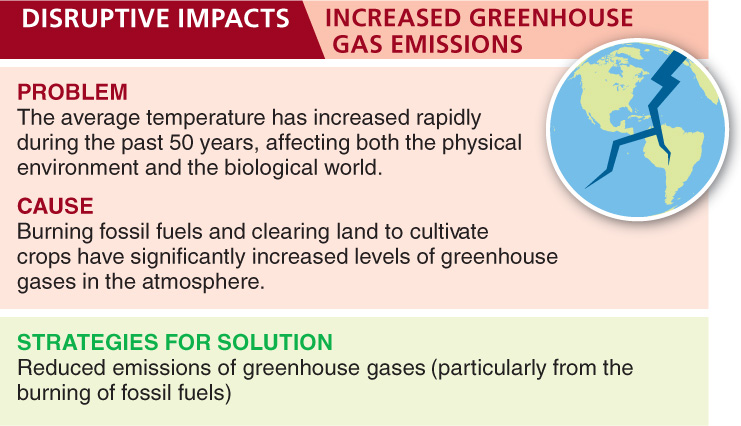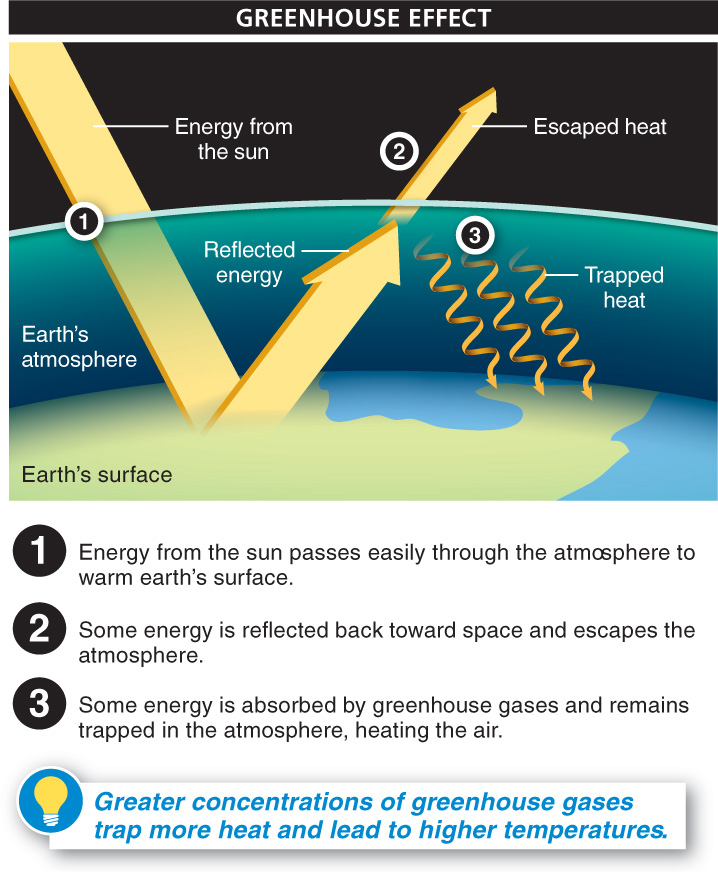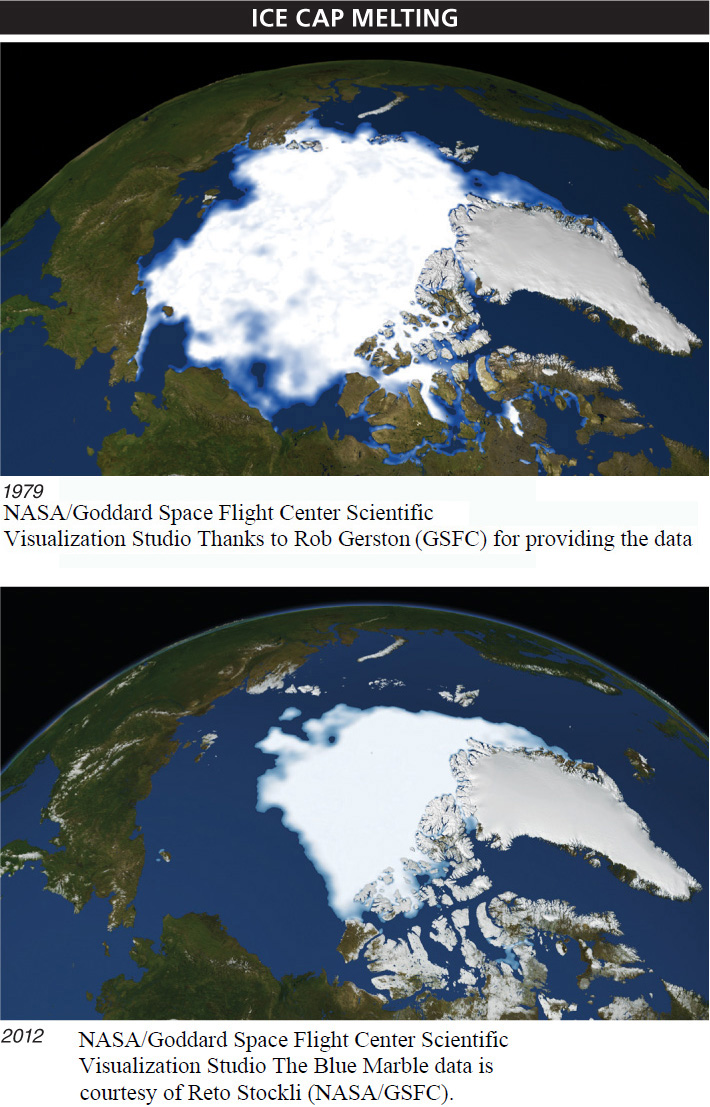Not long ago, debates about global climate change focused on two questions: “Is it real?” and “Is it caused by human activities?” Now, the vast majority of scientists believe that the answer to the first question is yes and that it is very likely that the answer to the second question is also yes. As a consequence, the scientific debate has increasingly moved to questions such as “What effect will global climate change have on the world we know?” and “How can we stop it?” Nonetheless, in part because of the significant political implications of global climate change—
Some of the evidence that the earth’s atmosphere is warming comes from weather records that extend back into the 1700s. Those records show that the average temperature has increased rapidly during the past 50 years and that 18 of the 20 hottest years on record have occurred since 1990 (FIGURE 16-24). Three centuries is a substantial time from the perspective of an individual human, but it’s less than the blink of an eye in the history of the earth. Data from a report on Antarctic ice cores, published in the journal Science in 2007, extend the temperature records back to more than 800,000 years ago.

These ice cores reveal regular cycling between periods of cold climate (“glaciations”) and warmer climate on earth and show that we are currently nearing the end of a colder period. But while they document that the current temperatures are not the highest on record, the Antarctic ice cores reveal some dramatic information about certain “greenhouse gases” in the atmosphere that are associated with global warming. In particular, they show that the current levels of carbon dioxide and methane in the atmosphere are far higher than any that have occurred during the 800,000-
The term “greenhouse effect” describes the process by which energy from the sun warms the earth’s atmosphere. The light we see lies in the visible portion of the light spectrum, and visible wavelengths of light pass easily through the atmosphere to warm the earth’s surface. Some energy in the infrared part of the spectrum flows from earth back toward space, and several gases in the atmosphere absorb this energy, heating the air (FIGURE 16-25). These gases act like the glass panels that make up the roof of a greenhouse: they allow light energy to pass through, but they keep heat from escaping—

670
Why do we blame global warming on humans?
Humans have increased the amount of greenhouse gases in the atmosphere. And we’ve done it for primarily one reason: we rely on the burning of fossil fuels—
The Intergovernmental Panel on Climate Change, a scientific body set up in 1988 by the World Meteorological Organization and the United Nations, has predicted an increase in the average annual temperature of 2° to 12° F (1° to 6.4° C) during the 21st century. Sea levels will rise by 7–
Both environmental and biological evidence already reveal the effects of global warming. The Arctic Ocean ice cap is melting, and the glaciers that cover Antarctica and Greenland have also been melting at unprecedented rates—

Biological systems are also showing the effects of climate change. Trees and flowers in northern latitudes are blooming earlier in the spring than they used to; migratory birds are arriving at their summer ranges earlier than they did even a decade ago; and birds and butterflies are extending their geographic ranges northward.
The changes to the physical environment caused by global warming, such as the thinning and shrinking of the Arctic Ocean ice or the flooding of coastal estuaries, can have profound effects on biodiversity at the species and ecosystem levels. For example, in 2004, a research ship in the Arctic Ocean found nine walrus calves swimming alone in deep water. Normally, adult female walruses leave their calves on ice floes in shallow water while they dive to the seafloor to feed on clams and crabs, and then return to the ice to nurse their calves. But the Arctic ice cap over shallow water has melted, driving the female walruses to the remaining ice, which is in deep water. The mother walruses cannot dive deep enough to reach the sea bottom, and they seem to be abandoning their calves.
Other consequences of global warming reveal the tremendous interconnectedness of so many ecosystem elements. Many bird and butterfly species’ migratory patterns have been altered as they search for lower temperatures. Many populations of small mammals living near high-
671
Infectious disease experts have warned that global climate change is likely to alter the distribution of disease vectors—
Global warming is a difficult issue to tackle because it is so large in scope; it encompasses every biome, every ecosystem, every species, and every body of water, and its solutions require individual efforts in all nations as well as international cooperation among governments. Fundamentally, however, the science is straightforward: carbon emissions must be reduced significantly. This can be done by individuals who choose to cut down on their own fossil fuel use, improve the energy efficiency of their homes and cars, and support the development of carbon-
TAKE-HOME MESSAGE 16.10
Carbon dioxide and methane are called “greenhouse gases” because they trap heat in the atmosphere. As humans burn fossil fuels and clear forests, the concentrations of greenhouse gases have been increasing and global temperatures have been rising. Ecological changes in plant and animal communities have already been observed and are likely to become more serious unless there is a global reduction in emissions of greenhouse gases.
Is global warming real, and is it caused by human activities?
Yes to both. There is no longer any question that human activities contribute to global warming. Today, the most pressing issues are: (1) determining the effects of global warming and (2) determining how to stop the trend.